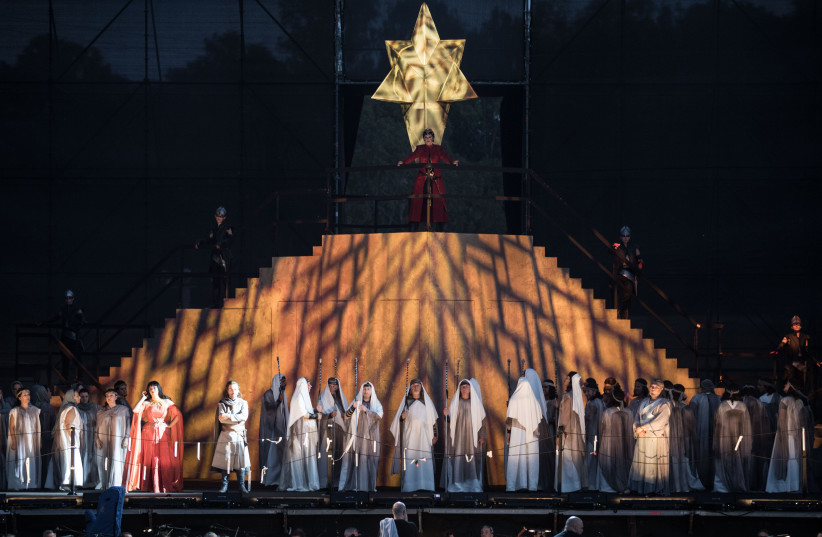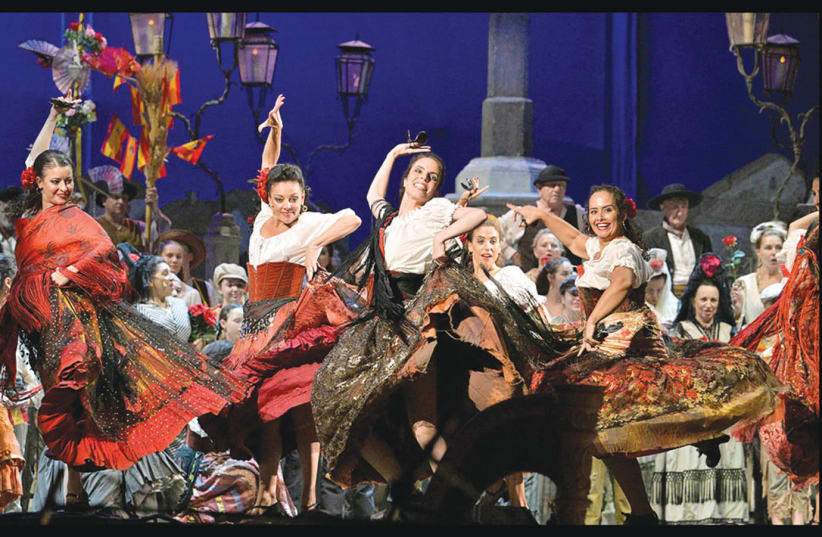Thousands flocked to Tel Aviv’s Park Hayarkon on Thursday evening for a free performance of Bizet’s iconic 1875 opera Carmen. Based on the 1845 same-titled novella by Prosper Mérimée, the plot revolves around Carmen (Na’ama Goldman) and Don Jose (Leonardo Caimi). Jose is a naïve French soldier swept off his feet to his utter destruction by a pretty Roma girl, who is true to herself and her heart against heaven itself.
The opera's storyline
Bizet, who declined to visit Spain while working on the opera stating it would only confuse him, gifted us with visions of bullfighters and dancing Roma girls that seems timeless.
When Oded Reich (Escamillo) entered the stage in the traditional costume of the Matador and began the famous aria “Votre toast” (I toast you), the delighted patrons began to clap to the rhythm of the famous tune, also known as “Toreador song.” The public was aided in this abbreviated production by non-other than Tel Aviv Mayor Ron Huldai. Wearing a buttoned blue shirt, Huldai lauded the return of the opera in the park tradition after a COVID-enforced two-year hiatus and offered that “opera is one language we can all understand, the language of love and music.”
“Opera is one language we can all understand, the language of love and music.”
Tel Aviv Mayor Ron Huldai

“L’amour est enfant de boheme, il n’a jamais, jamais connu de loi” (Love is a gypsy girl who knows nothing of the law) sang Goldman during the “L’amour est un oiseau rebelle” (Love is a rebellious bird) aria, commonly known as “Habanera.” Her precise delivery of the French libretto was spellbinding, and her iconic red dress and white corset, long associated with the role, shone in bright colors on the two large screens flanking the stage.
The screens served the huge-scale production well by offering patrons close-ups at key moments of the performance. During important scenes, such as the “C’est toi, c’est moi” (It is you, It is I) aria, drones hovered and flew around the stage to offer those watching the live stream at home a full view of the outstanding performance. The final confrontation between Carmen and her former lover.
“HABANERA” WAS originally composed by Basque composer Sebastian Iradier, and Bizet mistook the tune for a Spanish folk song and swiftly added the correct attribution when informed of his faux pas. The full libretto is packed with cultural references that enrich our experience of this great opera. When Escamillo is introduced, the Roma girls inform us he wishes to rival the great Pepe-Hillo, a real bullfighter painted by Goya. When Carmen is fed up with Don Jose, she tells him to pick up his Shako, a tall military cap, and leave. These details, along with the entire subplot of Micaela (Alla Vasilevitsky) delivering two letters from Don Jose’s mother, were removed to keep the production short. Yet, at the cost of some great arias (“March of the Smugglers” is one), we were given something extraordinary. As living costs mount higher and higher, and inflation soars, there is a deep humanistic value in offering to the public a free opera of the highest artistic merit. Despite her reduced role, Vasilevitsky shone as the good-natured woman Don Jose could have chosen, had he been able to resist Carmen.
In his genius, Bizet created an opera in which we are constantly told to watch out (“Prends garde a toi – Beware” during “Habanera”) and to realize we are watched by dark eyes (“Qu’un œil noir te regarde – That a black eye considers you” during “Toreador Song”). These dark eyes are not explicitly identified as female; they could very well be the bull’s, or death.
“Toreador Song” is about a brave bull that is such a great force of nature it topples the picador off his horse and wins the approval of the crowd. In the final scene between Carmen and Don Jose, which takes place when Escamillo is busy in the ring, we can hear what is going on there.
The libretto invites us to compare the bull being mortally wounded nearby to the two leads. Who is the sacrificial bull? Is it Carmen, who refuses to leave Escamillo for Don Jose or is it Don Jose who was led to his complete destruction by forces larger than himself?
When Carmen invites Don Jose to join her people and become a smuggler during the “Bel oficier, bel oficier” (Handsome Officer) aria, she offers a clear stand on life: One’s own will is the law (Et pour loi sa volonté). Don Jose is unable to shake off his upbringing, the law is external to our own will and must be obeyed. The dark eyes watching us can also be the grim reaper, which hovers above the production as a large cross. Death is also each person’s unavoidable fate, sung about during the “In Vain” aria (En vain pour éviter). This is the tarot card-reading scene in which Carmen learns she will die soon.
The lively and greatly enjoyable production owes a huge debt to the Israeli Opera dancers, who shone near the Walls of Seville, as they danced a glorious flamenco at the tavern owned by Lillas Pastia. The friend Carmen refers to when she seduces Don Jose.
Reich, holding the traditional multi-colored muleta used by bullfighters to goad the animal in the ring, deserves a nod as well for a superb performance. The delighted crowds were sent home with a dazzling firework production that lit the night sky over the park and shone, for a brief moment, on the various paths available to us on our respective journeys.
